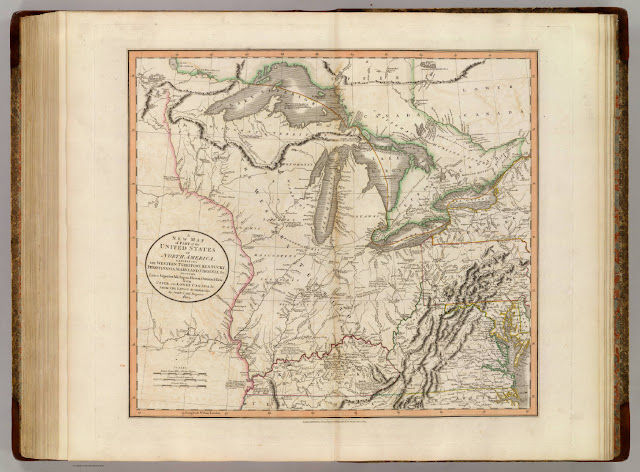We know so little for certain about this maternal third great grandmother but a few things seem clear. The oldest daughter of Phoebe Budd? (1775?-1845?) and Caleb Gaskill (1775-1837), her given name is consistently spelled "Catharine" (including on her gravestone) not the more usual "Catherine." Also census records almost always list her birthplace as Pennsylvania, most likely in Brownsville Township in
Fayette County. Her paternal grandparents were
Hope Rossell and Caleb Gaskill and we can trace her lineage back to
Edward Gaskill.
The family moved to Ross County, Ohio,* in 1809 when Catharine was about five years old. Unfortunately the 1810 U.S. Census records for all Ohio counties except one do not survive so we don't know exactly where the Gaskills settled.**
[A new map of part of the United States of North America, exhibiting the Western Territory, Kentucky, Pennsylvania, Maryland, Virginia &c., also the lakes Superior, Michigan, Huron, Ontario & Erie; with Upper and Lower Canada &c. From the latest authorities. By John Cary, engraver. 1805. London: Published by J. Cary, Engraver & Map-seller, No. 181, Strand, June 1st, 1805.
Source: David Rumsey Historical Map Collection.]
[Detail of above map showing location of Brownsville and general area surrounding Chillicothe in Ross County.]
On March 2, 1820, Catharine married Henry Freeman*** who apparently died the following year. A year later his widow married Jesse Tomlinson in
Fayette County, Ohio.
In the 1830 U.S. Census, when Jesse Tomlinson's household was enumerated in Perry Township in the southwest corner of
Pickaway County, his family had grown to seven people including three little boys, a little girl, and an elderly man over 70 whose identity is unknown.**** Ten years later the Tomlinson's were still living in Perry Township and had added four more children, two boys and two girls.*****
[Perry Township; Ancestry.com. 1830 United States Federal Census [database on-line]. Provo, UT, USA: Ancestry.com Operations, Inc., 2010. Images reproduced by FamilySearch. Original data: Fifth Census of the United States, 1830. (NARA microfilm publication M19, 201 rolls). Records of the Bureau of the Census, Record Group 29. National Archives, Washington, D.C.]
[Perry Township; Ancestry.com. 1840 United States Federal Census [database on-line]. Provo, UT, USA: Ancestry.com Operations, Inc., 2010. Images reproduced by FamilySearch. Original data: Sixth Census of the United States, 1840. (NARA microfilm publication M704, 580 rolls). Records of the Bureau of the Census, Record Group 29. National Archives, Washington, D.C.]
In the 1850 U.S. Census, Catharine finally got her own listing. She and her family were now living in Union Township in
Madison County, Ohio, next door to her brother Noah Gaskill. Only six of their children were still living at home including my direct ancestor George who was 11 and their youngest child Albert who was three years old.
[Union Township is located west and south of London which isn't included in it; Detail of Map Of The State Of Ohio. Published By Thomas, Cowperthwait & Co. No. 253 Market St. Philadelphia. 1850. Source: David Rumsey Historical Map Collection.]
[Union Township; Ancestry.com. 1850 United States Federal Census [database on-line]. Provo, UT, USA: Ancestry.com Operations, Inc., 2009. Images reproduced by FamilySearch. Original data: Seventh Census of the United States, 1850; (National Archives Microfilm Publication M432, 1009 rolls); Records of the Bureau of the Census, Record Group 29; National Archives, Washington, D.C.]
In 1856 the Tomlinsons left Ohio for
Washington County, Iowa, where Jesse died on May 24, 1857. Three years later the 1860 U.S. Census listed Catharine as head of a household and a farmer . Two of her sons, Albert and George, were living with her and one of her other sons, Samuel, and his family were living nearby. (Note that Catharine's place of birth was listed as "unknown" which makes me think that she probably wasn't the person who answered the enumerator's questions.)
[Detail from A New Map of the State of Iowa. Published By Charles Desilver, No. 714 Chestnut Street, Philadelphia. Entered according to Act of Congress in the year 1856 by Charles Desilver in the Clerk's office if the District Court of the Eastern District of Pennsylvania. 35. Source: David Rumsey Historical Map Collection.]
["United States Census, 1860," database with images, <i>FamilySearch</i> (https://familysearch.org/pal:/MM9.3.1/TH-1951-25248-2235-2?cc=1473181 : accessed 21 March 2016), Iowa > Washington > English River Township > image 12 of 34; from "1860 U.S. Federal Census - Population," database, <i>Fold3.com</i> (http://www.fold3.com : n.d.); citing NARA microfilm publication M653 (Washington, D.C.: National Archives and Records Administration, n.d.).]
We haven't been able to locate Catharine in the 1870 U.S. Census but in
Grave Records of Washington County, Iowa, compiled by the Graves Registration Project of W. P. A. lists her date of death as May 2, 1874. She's buried near her husband in the Richmond Protestant Cemetery (now Richmond Public Cemetery). Find A Grave's photograph of her gravestone shows that it's been broken and only the top part appears to have survived
[Catharine, wife of Jesse Tomlinson, Richmond Public Cemetery, Washington County, Iowa.
Catharine and Jesse's son George Marion Tomlinson married
Elizabeth Taylor who died shortly after their daughter
Rufina Ellen Tomlinson was born in 1863. Fina married
Lewis Logan Slater and their second child,
Harry Allen Slater, is my maternal grandfather.
*
Chillicothe is the present county seat for
Ross County. In 1800
Chillicothe became the capital of the Northwest Territory and from 1803 through 1816 (except for a brief interval) it served as the Ohio state capital.
**I haven't been able to locate Caleb Gaskill in the 1820 U.S. Census either. In the 1830 U.S. Census his household was listed in
Scioto Township in Ross County but we don't know if that's where they settled when they first arrived in Ohio or whether they relocated once they were there.
***I haven't found any further information about Henry.
****Jesse's father died in 1815 and Catharine's father was still living in Ross County.
*****Another daughter, named Phoebe for her grandmother, was born in 1832 and died in 1836.
© 2016 Copyright, Christine Manczuk, All Rights Reserved.


















































